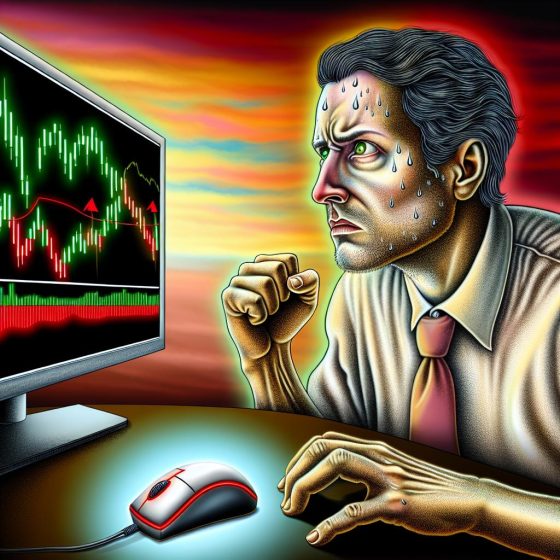Understanding the Root of Fear in Trading
Fear in trading is a natural and common emotion experienced by both new and seasoned traders. This fear typically stems from the potential of financial loss, coupled with the uncertainty and volatility inherent in the financial markets. Understanding the root causes of this fear can be the first step in overcoming it. Addressing the psychological underpinnings, developing strategies, and embracing education and practice are key components in mitigating these fears and achieving trading success.
The Psychology Behind Trading Fear
Fear in trading is closely tied to psychological factors. The prospect of losing capital can trigger a fight-or-flight response, activating stress that can impact decision-making abilities. Traders often fear making the wrong decision more than they fear loss itself. This fear can sometimes lead to trading paralysis, where traders are unable to pull the trigger on trades, potentially missing out on profitable opportunities. The presence of fear isn’t necessarily detrimental; however, when left unaddressed, it can inhibit rational decision-making and undermine trading performance.
Identifying and Acknowledging Fear
An essential step toward overcoming trading fear is identifying and acknowledging it. Traders can start by reflecting on their trading experiences to pinpoint moments where fear influenced their decisions. By acknowledging these moments, traders can gain a clearer understanding of their triggers and begin to address them. Self-reflection enables individuals to assess behavioral patterns that consistently lead to undesirable outcomes.
Recognizing Fear-Induced Behavior
Common behaviors that arise due to fear include over-trading, hesitating to enter or exit positions, or excessively relying on rumors or uninformed opinions. Recognizing these tendencies allows traders to make adjustments. This recognition is instrumental because only with a firm grasp on how fear manifests can interventions be designed to counteract its impacts.
Developing a Strategy to Combat Fear
Once the sources and moments of fear are identified, developing a comprehensive strategy to combat these fears becomes critical. A well-reasoned strategy provides the framework needed to make informed, confident decisions. Structural strategies not only mitigate fear but also create an environment where emotions are channeled positively toward calculated risk-taking.
Creating a Trading Plan
A trading plan is pivotal in minimizing fear. This plan should outline entry and exit strategies, money management rules, and specific criteria for trade selection. By having a robust plan, traders can base their decisions on predefined criteria rather than emotion. This helps in reducing the fear of the unknown. A structured plan also ensures consistency in trading activities, fostering reliability in market interactions.
Backtesting Strategies
Backtesting involves applying a trading strategy to historical data to evaluate its performance without any financial risk. Conducting thorough backtesting helps traders understand how their strategies would have performed in past market conditions, which can instill confidence and reduce fear when executing trades in real-time. A robust backtesting process also highlights weaknesses in strategy that might need adaptation to current market dynamics, ensuring strategies remain relevant and effective.
Adapting Strategies Based on Feedback
Feedback from backtesting can be used to iteratively refine and improve strategies. This readiness to adapt further diminishes fear as traders grow more confident in a plan that evolves in response to real-world data, effectively turning market learning curves into opportunities for growth rather than sources of apprehension.
Embracing the Role of Education and Practice
Knowledge and experience are powerful tools in overcoming fear in trading. Continued education and practice equip traders with the necessary skills and confidence to make sound trading decisions. A strong educational foundation acts as a buffer against the unpredictable nature of financial markets.
Continuous Learning
The financial markets are constantly evolving. As such, continuous learning is essential. Traders should consider enrolling in trading courses, reading books, and consuming reliable market analyses to enhance their understanding. Additionally, participating in forums and communities can provide insights and perspectives from other traders. A resource worth exploring could be the daily updates on Investing. Continuous learning keeps traders abreast of economic shifts and technological advancements that could influence market conditions.
Simulated Trading
Simulated trading accounts offer traders the opportunity to practice their strategies in a risk-free environment. By using demo accounts, traders can refine their methods without the fear of financial loss, gradually building the experience and confidence needed to execute real trades smoothly. This practice mode also allows for experimentation with new strategies, reducing the trial-and-error risks associated with live trading.
Building Confidence Through Experience
The repetitions and exposure attained through simulated trading provide invaluable experiential learning. As familiarity with market behavior develops, a trader’s confidence grows, turning fearful moments into opportunities for skilled intervention.
Pulling the Trigger on the Perfect Trade
Overcoming fear in trading is a journey that requires patience, discipline, and continuous effort. When the groundwork is laid through understanding, planning, education, and practice, the fear that once halted a trader can transform into calculated confidence. This newfound confidence enables traders to pull the trigger on what they perceive to be a perfect trade, aligning with their strategic objectives and risk tolerance. Confidence does not equate to eliminating risk but rather acknowledging it as an intrinsic part of trading that can be managed and leveraged for success.
The Transition from Fear to Confidence
The transitional journey from fear to confidence involves incremental progress driven by measurable outcomes. Each successful implementation of a planned strategy when fortified by learning and practice strengthens a trader’s resolve.
In conclusion, by addressing the psychological components of trading fear, developing a robust strategy, embracing continual learning, and using practice tools, traders can position themselves to make rational and informed decisions. The path to overcoming fear in trading is personal, but with structured efforts, the fear barrier can be significantly reduced, leading to more composed trading experiences. Emphasis on self-awareness, continuous improvement, and strategically employing resources culminates in a trading outlook less dominated by fear, opening the doors to new trading possibilities.
This article was last updated on: April 14, 2025
